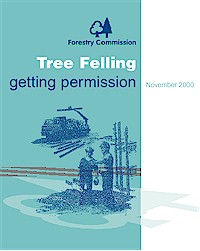
Tree Felling - Getting Permission
This Forestry Commission document provides advice and information relating to the
carrying out of works within forests, plantations and woodlands. It explains which kinds
of works are exempt from their control and the quantity of felling you can carry out
without formal permission being required.
The Forestry Act contains legislation which gives the Forestry Commission powers to
control the quantity of trees being felled at any one time. The basic rule is
as follows:-
The felling or selling of larger amounts will require a license from the Forestry
Commission. Certain types of felling do not need a license, some of the exemptions are
listed below.
- Felling trees with diameters less than 80mm (when measured at 1.3m from ground level).
- Felling trees for thinning purposes with diameters less than 100mm (when measured at
1.3m from ground level).
- Felling coppiced trees (for regrowth) with diameters less than 150mm (when measured at
1.3m from ground level).
- Lopping & Topping (Tree surgery, pollarding, pruning).
- Felling fruit trees.
- Felling Trees as part of a development.
- Felling necessary to prevent dangers or nuisance.
- Felling necessary to maintain utility services (carried out by utility companies?).
The above list is a short summary, for a complete listing you need to read the Forestry
Commission publication 'Tree Felling - Getting Permission'. This is available as a leaflet
from the Forestry Commission or as a pdf file from either the FC site or from the AIE.
- Click here to download 'Tree
Felling - Getting Permission' as a PDF file. Please
note this is 403kb in size so will take a few minutes to down load. You also need Adobe Acrobat File Reader to view/print the document. Once the
file has loaded into your browser use the File-Save (floppy disc icon on the Adobe menu)
to save it permanently to a folder within your hard drive.
|